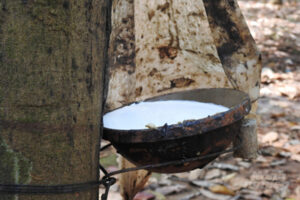Cambodia’s rubber exports declined by 10.9 percent in 2023
Phnom Penh, Cambodia – The Phnom Penh Post reports that declining global latex prices impacted Cambodia’s latex and rubber wood export revenue in the first seven months of 2023, resulting in a 10.9 per cent drop in value to $230 million from $257 million in the corresponding period last year.
The average price of latex per tonne is below 15 per cent at $1,337 per tonne (about $244) compared to the same period in 2022. The price of rubber wood is $215 per cubic metre.
According to the General Directorate of Rubber, total exports of both products were 170,968 tonnes. Of that, latex export, which represented the larger portion of the segment, was worth $228.5 million while rubber wood exports totalled $1.1 million.
Administration and Legislation Department director Khuon Phalla of GDR, an agency under the Ministry of Agriculture, Forestry and Fisheries agency, said apart from falling global latex prices, recent years’ economic crisis and exchange rate fluctuations have reduced the demand for latex, amid an increase in global latex inventory.
Speaking to the Post on Sept 3, Phalla pointed out that as of July 2023, new rubber plantations in Cambodia have increased.
By the end of last year, the size of rubber plantations in Cambodia was 404,578ha, where 78 per cent or 315,332ha is tapped for latex, while the rest consists of immature trees.
Earlier this year, plantation owner and exporter Men Sopheak, CEO of Sopheak Nika Investment Agro-Industrial Plants Co Ltd, said the Russia-Ukraine war and Sino-Taiwan tension were the main causes for the fall in global latex prices, which affected demand.
“We know that the Chinese market accounts for 70 to 80 per cent of the world’s total demand. The slow demand is [further compounded] by the problems in Europe,” he said.
Separately, Chea Vuthy, secretary-general of the Council for the Development of Cambodia (CDC) said last month that the car tyre industry in Cambodia has shown significant progress, with two companies considering the setting up of new plants.
Cambodia has three car tyre factories operating in Svay Rieng (Bavet), Preah Sihanouk and Kratie special economic zones.
“There will be two more companies in the near future,” Vuthy said, noting that the investors were studying the location for the factory in special economic zones.
He estimated that when all five companies are fully operational, they would be able to absorb about 200,000 tonnes of local natural latex production per year. The current latex yield per year in Cambodia is around 500,000 tonnes.
However, the lack of demand in the local market meant that almost all the latex were shipped to international markets.
Vuthy said according to the Cambodian Rubber Plantation Association, the official export of latex is about 300,000 tonnes, while unofficially, it is about 200,000 tonnes.
So far, only one of the three factories buys Cambodian latex. In the first five months of 2023, the company purchased 14,000 tonnes of local latex.
“Most of the raw materials for the production of car tires in Cambodia are imported from neighbouring countries,” he said.
In 2022, Cambodia earned more than $531 million from the export of latex and rubber wood.
Of that, the income from latex exports was more than $527.8 million with rubber wood exports totalling $4 million.

